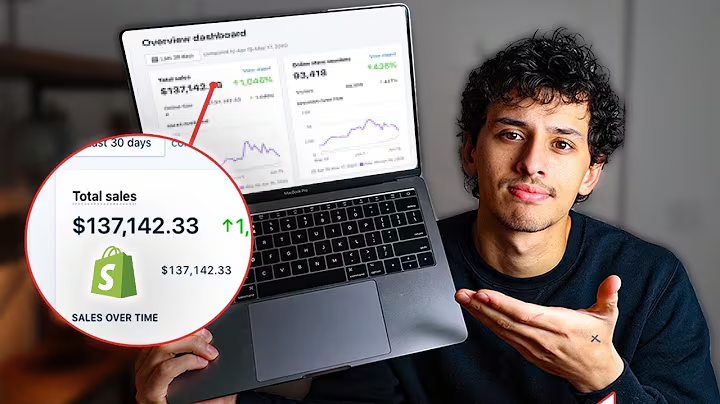Choosing Between Amazon FBA and Dropshipping: Pros and Cons
Table of Contents
- Introduction
- Understanding Drop Shipping
- Understanding Amazon FBA
- Pros and Cons of Drop Shipping
- Pros and Cons of Amazon FBA
- Key Differences between Drop Shipping and Amazon FBA
- Which Business Model is Right for You?
- Starting a Drop Shipping Business
8.1 Choose a Selling Channel
8.2 Selecting Drop Shipping Suppliers
8.3 Building an Online Store
8.4 Product Research and Selection
8.5 Testing the Market
8.6 Scaling Your Business
- Starting an Amazon FBA Business
9.1 Setting Up an Amazon Seller Central Account
9.2 Product Research and Selection
9.3 Negotiating with Manufacturers
9.4 Shipping and Labeling
9.5 Listing and Selling Your Products
9.6 Fulfillment and Customer Service
- Conclusion
Drop Shipping vs Amazon FBA: Which Business Model is Right for You?
In the ever-expanding world of e-commerce, choosing the right business model is crucial for success. As a new online seller, you may find yourself torn between drop shipping and Amazon FBA (Fulfillment by Amazon). While both models offer opportunities for budding entrepreneurs, it's important to understand the key differences and weigh the pros and cons before making a decision.
Understanding Drop Shipping
Drop shipping is a fulfillment model that allows you to host an online store without holding any physical inventory. Instead, you source products from suppliers and list them on your store. When a customer places an order, you simply forward the order details to the supplier, who then ships the product directly to the customer. This means you never have to handle the products or worry about inventory management.
Pros of Drop Shipping
- Low upfront investment: Since you don't need to purchase inventory upfront, you can start a drop shipping business with minimal capital.
- Low risk: With no inventory to manage, you can easily pivot and test different products without incurring losses.
- Scalability: Drop shipping tools automate various aspects of the business, allowing you to scale your store efficiently.
- Flexibility: You can sell a wide range of products from multiple suppliers, giving you the freedom to explore different niches and target audiences.
Cons of Drop Shipping
- Higher competition: Drop shipping is an accessible business model, leading to increased competition in the market. However, it's possible to differentiate yourself with unique products and effective marketing strategies.
- Limited control over stock availability and shipping times: Since you rely on suppliers for fulfillment, you have less control over these aspects. It's essential to work with reliable drop shipping suppliers to ensure timely and quality delivery.
Understanding Amazon FBA
Amazon FBA is a service provided by Amazon that allows sellers to store their products in Amazon's fulfillment centers. Sellers ship their inventory to Amazon, and the company takes care of storage, packaging, shipping, and customer service. When an order is placed, Amazon handles the entire fulfillment process on the seller's behalf.
Pros of Amazon FBA
- Credibility and trust: Amazon is a reputable and widely trusted brand, giving sellers an edge when it comes to credibility.
- Intentional organic traffic: Selling on Amazon means access to a massive customer base actively looking to purchase products, generating organic traffic to your listings.
- Efficient order fulfillment: Amazon's fulfillment centers ensure fast and reliable shipping, maximizing customer satisfaction.
- Free shipping and returns: Amazon Prime members enjoy free shipping and hassle-free returns, making it attractive for customers.
Cons of Amazon FBA
- Upfront investment: As an FBA seller, you need to purchase inventory upfront, which requires a higher initial investment compared to drop shipping.
- Strict rules and regulations: Amazon's platform comes with stringent policies and guidelines that sellers must adhere to. Violations can lead to account suspension or other consequences.
- Limited control over branding: FBA packages are typically shipped in Amazon-branded packaging, making it harder to establish a unique brand identity.
- Seller fees and FBA fees: Sellers must understand and account for various fees associated with selling on Amazon, including referral fees, storage fees, and FBA fees.
Key Differences between Drop Shipping and Amazon FBA
- Inventory management: Drop shipping doesn't require holding inventory, while FBA sellers need to purchase and send their products to Amazon's warehouses.
- Upfront investment: Drop shipping has minimal upfront costs, while FBA requires significant investment in inventory.
- Control over stock and shipping times: Drop shippers have less control over these factors as they rely on suppliers, while FBA sellers have more control due to storing inventory in Amazon's warehouses.
- Competition: Drop shipping has higher competition due to its accessibility, but it can be overcome by selecting unique products and working with multiple suppliers. FBA also faces competition, but Amazon's customer base offers significant exposure.
Which Business Model is Right for You?
The choice between drop shipping and Amazon FBA depends on your specific circumstances and goals. If you're a beginner, have a limited budget, or want to test the market before investing heavily, drop shipping may be the ideal starting point. It provides low-risk entry and the opportunity to scale with automation tools.
However, if you have the funds to invest in inventory upfront and prefer the credibility and reach of a trusted platform like Amazon, FBA could be a better fit. It offers efficient order fulfillment, access to Amazon's vast customer base, and the potential for higher profits. Remember to consider the associated fees and comply with Amazon's rules and regulations.
Ultimately, the key is to evaluate your priorities, resources, and long-term goals to make an informed decision that aligns with your business vision.
Starting a Drop Shipping Business
Once you've decided on the drop shipping model, follow these steps to start your online business successfully:
1. Choose a Selling Channel
Decide where you want to sell your products. Options include eBay, Shopify, Facebook Marketplace, Wix, WooCommerce, and more. Research each platform's features, audience, and fees to find the best fit for your business.
2. Selecting Drop Shipping Suppliers
Finding reliable and high-quality drop shipping suppliers is essential for your business's success. Consider factors such as product quality, shipping times, pricing, and customer service. Use trusted directories, such as Alibaba, to connect with verified suppliers.
3. Building an Online Store
Create your own website or set up a store on your chosen platform. Pay attention to design, user experience, and branding to create a professional and appealing online store.
4. Product Research and Selection
Thoroughly research the market and analyze trends to identify profitable products. Consider factors like demand, competition, pricing, and target audience. Use tools like Auto DS to automate product importing, price monitoring, and more.
5. Testing the Market
List your selected products on your online store and start promoting them through marketing strategies like social media advertising, influencer partnerships, and email marketing. Monitor sales, customer feedback, and market response to determine product viability.
6. Scaling Your Business
As you gain more experience and data, continue refining your product selection and expanding your supplier network. Leverage automation tools to manage inventory, orders, and pricing. Focus on optimizing marketing campaigns and customer experience to scale your business.
Starting an Amazon FBA Business
If you decide that Amazon FBA is the right choice for your business, follow these steps to start selling on the platform:
1. Setting Up an Amazon Seller Central Account
Register for an Amazon Seller Central account and complete the verification process. Choose between the individual plan (pay-per-sale) or professional plan (monthly subscription fee) based on your business needs.
2. Product Research and Selection
Conduct thorough product research using tools like Jungle Scout or Helium 10 to identify profitable opportunities. Consider factors such as demand, competition, sales rank, and product reviews to make informed choices.
3. Negotiating with Manufacturers
Source products from manufacturers or suppliers who can create and deliver your chosen products. Negotiate prices, minimum order quantities, and shipping terms to ensure favorable terms for your business.
4. Shipping and Labeling
Create shipping plans in your Amazon Seller Central account, specifying the quantity and details of the products you're sending to Amazon's warehouses. Follow Amazon's guidelines for packaging and labeling to ensure smooth handling.
5. Listing and Selling Your Products
Create product listings in your Amazon Seller Central account, including accurate product descriptions, high-quality images, and competitive pricing. Optimize your listings with relevant keywords and track performance using available analytics tools.
6. Fulfillment and Customer Service
Amazon takes care of order fulfillment, shipping, and customer service for your FBA products. Monitor inventory levels, respond to customer inquiries, and handle any necessary returns or customer feedback promptly.
Conclusion
In the dynamic world of e-commerce, choosing the right business model is crucial for success. Drop shipping and Amazon FBA offer distinct advantages and considerations. While drop shipping provides low-risk entry, scalability, and minimal upfront investment, Amazon FBA offers credibility, efficient fulfillment, and access to a vast customer base.
Consider your financial resources, goals, and preferences to determine the best fit for your business. Drop shipping allows for flexibility, while Amazon FBA offers the credibility and reach of a trusted platform. Regardless of your choice, thorough market research, effective product selection, and strategic marketing are essential for success in the competitive online marketplace.



















